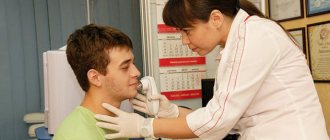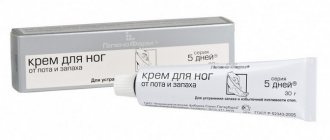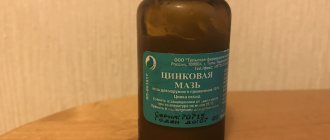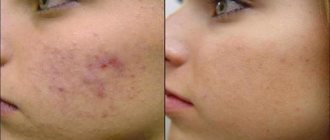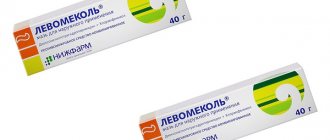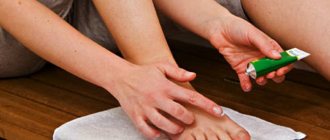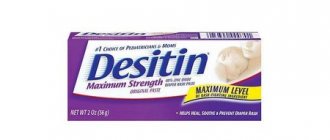Composition and release form
This drug is available in several dosage forms:
- Pills;
- Ointment (external and ophthalmic);
- Lyophilisate (powder for preparing a solution).
The main and most important substance is Erythromycin , an antibiotic of natural origin from the group of macrolides. Its most important advantages include:
- Extensive spectrum of antibacterial activity;
- Extremely low toxicity;
- Effective penetration into the epidermis.
- High concentration in tissues.
This substance does not have photosensitivity, which means that you can be in direct sunlight during use without harming your skin.
Side effects of antibiotics
Side effects of antibiotics most often occur when administered orally.
The most common of them:
- Hepatotoxicity - in particular, drug-induced hepatitis;
- Allergic reactions , including allergic urticaria;
- Changes in the qualitative composition of the blood - thrombocytopenia, leukopenia, anemia, azotemia;
- Neurological disorders - dizziness, excessive drowsiness with sufficient sleep, lethargy and sleep disturbances;
- Gastrointestinal tract function disorders - dyspeptic symptoms: nausea, loss of appetite, vomiting, inflammation of the wall of the esophagus and stomach, diarrhea, constipation, malabsorption syndrome, dysbacteriosis and pancreatitis;
- Accumulation in bone tissue - contributes to disruption of its formation in children;
- Hearing impairment and hypovitaminosis.
Side effects when applied topically:
Special attention should be paid to the effect of antibiotics on the digestive system. When taken orally, the drugs act systemically on the body, that is, not only the bacteria that cause acne are affected, but also other bacteria, especially intestinal ones.
The antibiotic introduces an imbalance in the intestinal normal flora, as a result of which the number of beneficial bacteria can decrease, while the population of opportunistic bacteria can increase, which is why their negative effect on human digestion and well-being begins to appear.
It is also possible to disrupt the function of the gastrointestinal tract due to the effect on both obligate bacteria and opportunistic bacteria, which also leads to various manifestations of dyspepsia and dysbiosis.
To correct this negative side of antibiotic therapy, your doctor may prescribe drugs that stimulate the growth of normal intestinal flora:
- Linex - available in capsule form, cost from 250 rubles ;
- Bifikol - available in the form of a dry powder for preparing a suspension, cost from 180 rubles ;
- Bifidumbacterin forte - available in capsule form, cost from 120 rubles ;
- Hilak forte - available in the form of drops for oral administration, cost from 240 rubles ;
- Enterol - used in powder form to prepare a suspension, cost from 220 rubles .
Mechanism of action
Erythromycin is a substance in the form of a white powder that is poorly soluble in water, but very soluble in alcohol. It has a pronounced bacteriostatic effect, which means that bacteria stop developing and multiplying, and therefore their number stops increasing and the body can more easily cope with their destruction.
Pathogenic bacteria slowly develop an addiction to it, so this antibiotic can be used for a long time (three weeks) without losing its effectiveness.
If the medicine gets on the mucous membrane or in the eyes, rinse it immediately with plenty of water.
Possible undesirable effects of Erythromycin for acne
The negative effect of Erythromycin can only be detected when taking tablets. Some body reactions to the drug are observed:
- the appearance of allergies;
- pain in the digestive system;
- symptoms of diarrhea, nausea;
- fungal infections of the mucous membranes;
- weakness, excess weight;
- decreased immunity;
- Due to the heavy load on the liver, the body begins to be poisoned with harmful substances.
When using the ointment, redness of the skin may occur, and in rare cases, peeling. If the drug causes headache, swelling of the respiratory organs, stomach upset, nausea and vomiting, then you should urgently consult a specialist.
Acceptability of the use of erythromycin in children
Erythromycin ointment is allowed to be used in the treatment of children. It is prescribed to infants to treat skin rashes. It is also used in the treatment of infections that the baby contracted while passing through the birth canal.
Attention! Tablets are prescribed to children over 14 years of age.
Acceptability of erythromycin use during pregnancy
Pregnant women very often experience rashes on their skin. This is due to an increase in androgen levels and increased secretion of the sebaceous glands. Such changes are observed throughout pregnancy and reach a peak in the third trimester.
Attention! Treatment in the form of tablets during pregnancy is prohibited!
Treating acne during this period is a difficult task, because many medications are contraindicated, but short-term use of Erythromycin is safe for both the woman and the fetus. It can be used for severe forms of acne.
Worth remembering! The drug does not cross the placenta and is considered safe during any stage of pregnancy. But before using erythromycin ointment, you should consult your doctor.
When is erythromycin used?
Let's take a closer look at how and when this remedy is used.
For acne
For the treatment of acne, this drug is suitable in many ways:
- It's safe;
- Bacterial resistance to it slowly develops;
- Can be used over a long course (up to 3 weeks, which helps solve the problem of new inflammation);
- Penetrates well into tissues and creates the necessary concentration in the deeper layers of the skin.
All this contributes to the rapid disappearance of even large lesions of the skin.
For pimples and acne
For single pimples, this remedy will help get rid of them in the shortest possible time. And prevent the appearance of new inflammations in the same area. This is especially true in the treatment of acne, when new ulcers appear in place of already resolved inflammation.
For post-acne
In its pure form, the antibiotic does not have a whitening effect, but in combination with organic acids (when used in peels and serums that help exfoliate the epidermis) it can have an excellent anti-inflammatory and whitening effect.
When is an antibiotic prescribed for facial acne?
Antibiotics for facial acne are prescribed in the following cases:
- For acne that is resistant to impeccable facial hygiene and care using special gels, foams and scrubs;
- For long-term troubling acne , when the problem is persistent for many years;
- With frequent relapses of the appearance of profuse acne;
- In cases of preparing facial skin for cosmetic interventions , for example, mechanical, ultrasound and other types of cleansing and peeling;
- In order to prevent infection or suppress existing inflammation of both low and high intensity.
There are two main ways to take antibiotics for acne:
- Local is primary. It is preferable, since with a targeted effect on inflammatory elements of the skin, the effect of the drug is directed exclusively at this focus, and the side effects of a particular antibiotic are practically reduced to zero;
- Oral - prescribed in more severe cases, when the acne problem has been bothering you for a long time without periods of remission. Also, oral administration of these drugs is switched to if local application is ineffective. It is also possible to combine antibiotics locally and orally for a more powerful effect. However, in this case, along with the high effectiveness of therapy, side effects of drugs appear and appear, since the effect on the body in this case is systemic, that is, the active substance is carried through the blood to organs and tissues, adversely affecting them.
Ointment
Erythromycin ointment is a good, budget-friendly product that, combined with proper care, will help you achieve the desired result. In addition to the main active ingredient, the composition contains petroleum jelly and lanolin. Apply it precisely to areas of inflammation in a thin layer, on previously cleansed skin.
Chatterboxes
In this section, we have collected perhaps the best recipes for erythromycin shakes, which have proven to be effective and safe when used correctly. And the additional antibacterial components that are present in the composition will speed up the cleansing of the skin from annoying inflammations.
The biggest advantage of preparing the product yourself is its low price with good efficiency and speed of obtaining the desired effect.
With zinc
To prepare you will need to take:
- Salicylic acid – 20 ml;
- Boric acid – 20 ml;
- Erythromycin (250 mg/tablet) – 4 tablets;
- Baby powder – 2 gr.
The antibiotic must be crushed to a powder and mixed with powder (which consists of 50% zinc oxide and 50% talc). Next, pour boric and salicylic acid into one bottle and pour the resulting mixture into it. Mix well and let it brew in the refrigerator for one day. Shelf life – 14 days.
With tetracycline
The combination of two mutually reinforcing antibiotics, supplemented with dimexide, allows you to achieve an amazing effect in a short time. Just try it and the result will impress you.
To prepare you will need to take:
- Salicylic acid – 25 ml;
- Boric acid – 25 ml;
- Erythromycin – 2 tablets;
- Tetracycline – 3 tablets;
- Dimexide – 3 ml.
Mix boric and salicylic acids in one bottle. Grind erythromycin and tetracycline until smooth. Pour the resulting powder into a bottle and add dimexide there. Shake vigorously and let it sit for one day in the refrigerator. Shelf life – 14 days.
With calendula and aspirin
To prepare such an anti-inflammatory mash you will need to take:
- Calendula tincture – 1 bottle (40 ml);
- Erythromycin – 4 tablets;
- Aspirin – 4 tablets.
Aspirin and other tablets should be crushed to a powder and poured into a bottle with calendula. Shake well and let it brew for one day in the refrigerator. Apply the resulting composition to areas of inflammation twice a day - morning and evening. Don't wash it off. The shelf life is also 14 days.
With metranidazole and calendula
The recipe for such a mash is very simple:
- Metronidazole – 3 tablets;
- Erythromycin – 3 tablets;
- Calendula tincture – 1 bottle (40 ml).
All tablets must be crushed to a powder and poured into a bottle.
Mix thoroughly and apply to previously cleansed skin twice a day. Metronidazole in this composition will provide excellent support to the antibiotic and enhance its antibacterial activity.
Shake before use!
Masks
Face masks with erythromycin, at a very low cost, will greatly help you in the fight for the beauty of your skin, improve its condition and overall appearance. To get the best possible effect, we strongly recommend following the required proportions and maintaining the application time.
With dimexide
This mask is perfect for those with oily skin; it helps treat acne and other inflammations.
To prepare, take:
- Dimexide – 1 teaspoon;
- Erythromycin – 3 tablets;
- Warm water – 5 teaspoons.
Contraindications to taking erythromycin
Like any medicine, erythromycin for acne has both indications for use and contraindications. Any doctor prescribing an antibiotic must prescribe an antifungal drug. This case is no exception. In order to restore the disturbed microflora of the intestines and skin, you must definitely take what the doctor recommended.
Among the negative consequences that occur when taking the drug are the following:
With prolonged use of the product, it can cause dysbacteriosis; Fungal diseases; Nausea, gastrointestinal upset, severe weight loss; If the course of treatment is insufficient, a relapse of the disease is possible; Dryness, irritation of the skin; Peeling and feeling of skin tightness; Allergy.
It is recommended to use erythromycin from 14 years of age, not earlier. For adolescents, the drug is approved for use only as prescribed by a doctor. The product is contraindicated for pregnant and nursing mothers.
Erythromycin is an additional component in ointments, lotions and creams intended to eliminate skin infections.
Analogs
Analogues of erythromycin are usually prescribed in case of individual intolerance or ineffectiveness of this antibiotic.
Analogs include any antibiotic of the macrolide series. Also, in terms of effectiveness, they are overtaken by tetracyclines, but still they are weaker than macrolides, which are a generation higher.
In the table below you can see the compatibility of erythromycin with other antibiotics, and where there is a ++ , you can safely say that the antibiotic is similar. And when used together, their antibacterial activity increases.
If you want to supplement a mash or mask with an additional antibacterial component, thereby increasing its effectiveness, then consider exactly those drugs that are marked with two pluses.
How are antibiotics different from antimicrobials?
Is it possible to use drugs on the packaging that say “antimicrobial”, “antimicrobial”, “antiseptic”, “disinfectant” in the treatment of acne? To understand this, you need to understand the difference between them and antibacterial substances.
Features of antiseptics:
- The effect of antimicrobial agents is not selective on all unicellular life forms (all fungi, bacteria and viruses);
- Antimicrobial agents have found their use in the disinfection of surgeon's hands , various surfaces and objects, and the treatment of open wounds;
- In the case of fighting acne, such remedies are permissible only in the case of treating an opened pimple with or without bleeding to prevent infection of the wound.
Differences between antibiotics:
- Affects bacteria only;
- The action can be aimed at both a large number and a small number of sensitive bacteria, which is more common in the treatment of acne.
Other drugs containing erythromycin
The drugs listed below are highly proven to be effective, but their price is 3-5 times higher than regular ointment and can hit the average person hard.
Zenerite
This drug combines two active ingredients:
- Erythromycin;
- Zinc acetate.
As we already know, the first component has a pronounced bacteriostatic effect, and the second perfectly dries out inflammation and has an additional bactericidal effect.
Zenerite
Price from 600 rubles per package.
There is also an analogue on the market called zineriderm, which is extremely rare on pharmacy shelves.
Aknemix (Benzamycin)
A very interesting tool, with an equally interesting price. This drug combines two active ingredients:
- Erythromycin;
- Benzoyl peroxide.
Their complementary combination is very effective and allows you to quickly get rid of annoying inflammations.
However, the drug has two significant disadvantages:
- Insanely dry skin;
- Very high price - from 1700 rubles per package.
All medications described in the article are used externally, but to enhance effectiveness they are also taken orally. This drug has various contraindications and may cause unwanted side effects. Therefore, before use, consult your doctor to prescribe the dosage and duration of the course. Please take care of your health and do not self-medicate.
Features of the use of antibiotics
The use of each antibiotic has its own characteristics:
- The dosage should be selected as accurately as possible . Dosages are calculated, as a rule, in the amount of micrograms or milligrams per 1 kilogram of human body weight and should be optimal, causing its pharmacological effect in precisely this quantity;
- The antibiotic should be selected taking into account the condition of the entire organism as a whole; it is necessary to compare the diseases and conditions of the person with the side effects of the drug, for example, you should not prescribe nephrotoxic antibiotics to a person with diseases of the excretory system or antibiotics that impair the growth of bone tissue in children under 18 years of age;
- The third point echoes the first and is that the exact frequency of administration must be observed , in some cases even hourly (to prevent the occurrence of resistance, disruption of the natural biocenosis of the skin, secondary infection due to scratching irritated areas of the skin, etc.). This applies to both oral and local forms;
- When using antibiotics, you need to take into account their aggressive side effects in order to properly mitigate them.
Reviews
We invite you to read reviews from ordinary people about the use of erythromycin for acne and inflammation on the skin of the face, and if you still have any questions, you can always ask them to a cosmetologist or pharmacist on our cosmetic forum.
I would like to leave my review about the use of erythromycin ointment, which I used for acne on the advice of a therapist at our hospital. I liked the initial effect; some pimples at the very beginning did not even reach the acute phase, but resolved even at the ripening stage. However, what I really didn’t like about this ointment was its strong comedogenicity. I have a huge number of blackheads on my forehead and bridge of my nose.
Valentina, 27 years old, Reutov
Every spring and autumn I experience severe flare-ups and extensive rashes on my temples and T zone. A mask with honey, lemon and erythromycin helps me a lot in the fight against this. I do it twice a week, on Mondays and Thursdays. And in the evening, before going to bed, I cauterize the pimples with alcohol tincture of calendula and after a week and a half a pronounced effect is noticeable. Pimples mature faster and break out, and new rashes do not appear.
Ksenia, 22 years old, Ruza
I tried to treat the rash with a mash of erythromycin and tetrocycline, the effect was simply amazing. All my rashes on my forehead either matured quickly or disappeared without leaving even a spot. I processed it twice a day - morning and evening. Before use, be sure to wash your face several times with boric soap and remove any remaining moisture with a waffle towel.
Denis, 27 years old, Moscow
How to extend the effect?
How can you prolong the effect of antibacterial therapy on acne? Of course, proper further facial care and regular visits to a cosmetologist, who, like no one else, will properly monitor the condition of the facial skin.
You need to adhere to the basic rules:
- Thorough morning and evening cleansing - tar soap is perfect, moisturizing and nourishing the face. It is important to immediately take care of hypoallergenic skin care products in order to prevent possible additional exposure to negative factors on the skin and loss of treatment time to combat the consequences of the caused allergy;
- Maintaining a healthy diet - maximum limitation or complete exclusion of unhealthy foods, such as fatty, spicy, spicy, sweet foods;
- Adequate fluid intake - preferably at least two liters per day;
- Monitoring the condition of the skin - at the onset of recurrent conditions, repeat the course of complex antibacterial therapy;
- Preventive cosmetic procedures during periods of remission under the supervision of a physician.
Description of effective wound-healing ointments for mucous membranes in gynecology
Healing ointments for mucous membranes are often used in gynecology. Prescribed for many diseases, regardless of the reasons that caused damage to the mucosa. Based on their composition and mechanism of action, they can be divided into 3 large groups:
- Regenerating agents (Sea buckthorn ointment, Methyluracil, Vulnuzan). Wound healing ointments for the mucous membrane contain components that improve blood circulation and metabolic processes in tissues, thereby stimulating the processes of regeneration of damaged tissues.
- Anti-inflammatory and antimicrobial drugs (Erythromycin, Tetracycline, Syntomycin, Povidone-Iodine). Ointments for healing wounds on the mucous membrane contain antibacterial components, inhibit the development of pathogenic microorganisms that cause inflammatory processes, and prevent the development of infectious complications.
- Combined medications (Levomekol, Vishnevsky's balsamic liniment, Pantestin). Healing ointments for mucous membranes contain both antibacterial and antiseptic, as well as regenerating components.
Sea buckthorn ointment
Sea buckthorn ointment is an effective herbal preparation, widely used in gynecology for the treatment of colpitis, inflammation of the vaginal mucosa, and cervical erosion. In addition to healing ointment, sea buckthorn oil can be used to speed up the restoration of damaged mucosal surfaces. The drug is used three times a day for at least a week.
Methyluracil
Methyluracil, which is part of the drug, improves metabolic processes and blood circulation in damaged tissues, exhibits pronounced regenerating properties, and reduces the healing time of damaged epithelium. Also, the pharmacological agent has an immunostimulating and anti-inflammatory effect.
In gynecology, Methyluracil is often prescribed to women immediately after childbirth to heal microcracks and serious tears, accelerate the healing of sutures and prevent the formation of scars after surgical interventions. Gynecological tampons with healing vaginal ointment are inserted into the vagina 2-3 times a day for 4-7 days.
Vulnuzan
A biological stimulator of regenerative processes of natural origin, obtained by processing the mother liquor of Lake Pomorie. The drug has pronounced regenerating properties and exhibits antibacterial activity. In gynecology, it is used to treat cervical erosion and accelerate healing after operations. Tampons with medicine are administered once a day before bedtime for 15 days.
Tetracycline ointment
A local drug based on the antibiotic tetracycline has a wide spectrum of antimicrobial activity and inhibits the development of most gram-positive and gram-negative bacteria. The drug also exhibits anti-inflammatory and regenerating properties.
Tetracycline ointment is used in gynecology to treat various diseases caused by pathogenic microorganisms. In the treatment of genital herpes and inflammation of the appendages, the drug with tetracycline is especially effective. The method of using tampons with Tetracycline ointment in gynecology is standard, the frequency of administration is once a day.
Erythromycin ointment
Erythromycin is a macrolide antibiotic that is active primarily against gram-positive bacteria. In gynecology, Erythromycin ointment is usually used in the treatment of diseases caused by bacteria resistant to tetracycline, chloramphenicol, streptomycin. The frequency of use of Erythromycin ointment in gynecology is once a day. The duration of therapy is determined by the doctor individually.
Important! The main disadvantage of using tampons with Erythromycin ointment in gynecology is the rapid development of bacterial resistance to erythromycin.
Sintomycin
The drug based on the antibiotic chloramphenicol is characterized by a broad spectrum of action and inhibits the development of bacteria resistant to sulfonamides and tetracycline. In gynecology it is used to treat inflammatory diseases caused by pathogenic flora. However, with prolonged use it can provoke the development of candidiasis.
Povidone-Iodine
A pharmacological agent with the active ingredient of the same name is available in the form of an ointment and solution for external use. It has a pronounced disinfectant and antiseptic effect, and is active against most gram-positive and gram-negative bacteria.
The solution in gynecology is used to disinfect the birth canal before surgery (insertion of an intrauterine device, termination of pregnancy, etc.). Indications for prescribing the ointment are specific and nonspecific vaginitis, candidiasis, genital herpes, trichomoniasis, preparation for surgery.
Levomekol
A combined product based on the regenerating component methyluracil and the antibiotic chloramphenicol. The active components effectively suppress the development of pathogenic flora, relieve inflammation, and stimulate the restoration of damaged tissues.
In gynecology, the ointment is used to heal wounds on the mucous membrane after childbirth or surgery, in order to suppress pathogenic flora during colpitis. For the treatment of gynecological pathologies, therapeutic tampons are administered daily once a day.
Important! For cervical erosion, the drug is used with great caution, only after a complete gynecological examination, since methyluracil can provoke the development of a tumor process.
Vishnevsky ointment
The medicine contains tar, xeroform, castor oil. In gynecology, it is used to heal postpartum fissures and ulcers, treat cervical erosion, accelerate recovery and prevent infectious complications after operations. The frequency of use of the drug is once a day, the duration of therapy is at least a week.
Pantestin
The product based on dexpanthenol has a pronounced regenerating effect, accelerates the healing of wounds and damage to the mucous membranes. And thanks to the miramistin included in the composition, the antifungal and antibacterial effect of the drug is achieved. In gynecology, a restorative and healing gel is used to treat colpitis and cervical erosion.
